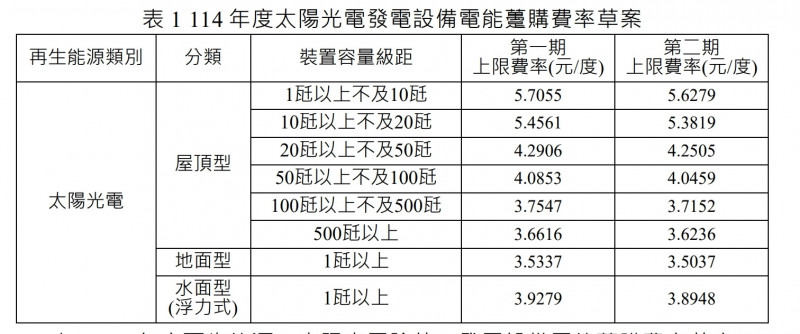The Ministry of Economic Affairs announced the draft "2025 Renewable Energy Feed-in Tariff Rates" on December 12, aiming to promote widespread adoption of small rooftop solar and small hydropower systems. For the upcoming year, the feed-in tariff rate for small rooftop solar systems will remain unchanged, while rates for other categories will decrease by approximately 2% to 5%. Additionally, in response to industry feedback, a new minimum tier has been introduced for small hydropower systems, with a rate of NT$4.9548 per kilowatt-hour.
The Energy Bureau announced the feed-in tariff rates for seven key energy types: solar, wind, biomass, waste-to-energy, small hydropower, geothermal, and marine energy. Solar power tariffs will continue to be split into two periods for the first and second halves of the year, with a reduction of about 2% to 5%. Among the eight solar power categories, only the rate for small rooftop solar systems under 10 kW remains unchanged at NT$5.6 to NT$5.7 per kWh. The bureau noted that while rates for systems under 20 kW should have decreased by 6%, the reduction was limited to 2% to encourage smaller projects.
Ground-mounted solar systems will see the steepest rate cut, dropping to NT$3.5 per kWh—a decrease of about 5.1%. The bureau explained that this reflects the maturity of solar technology and accounts for factors such as price fluctuations, labor shortages, and material supply issues, aligning with global trends of continued cost reductions.
Regarding the potential phasing out of solar feed-in tariffs, Energy Bureau Deputy Director Lee Jun-li stated that solar costs are declining in the long term. However, moving to a competitive bidding system prematurely could create market confusion. For now, the current mechanism will be maintained, with incentives still needed for certain projects. The bureau also highlighted that market purchase prices for solar power generally exceed NT$5 per kWh, with the proportion sold to Taipower through feed-in tariffs decreasing from 90% to 70%, and likely to diminish further.
For small hydropower, a new rate tier of 1 to 100 kW has been introduced at NT$4.9548 per kWh, while rates for other tiers remain at last year's levels. Deputy Director Lee emphasized that the bureau will continue to monitor market developments for small hydropower, which has gradually expanded from a single rate tier.
Marine energy continues to have a high feed-in tariff rate of NT$7.32 per kWh, second only to the NT$7.4 rate for small-scale onshore wind and the NT$7.3213 rate for small geothermal systems. Due to the diversity of marine energy types, Lee noted that it remains an emerging energy source with high costs. For now, a single rate is maintained, with potential adjustments after various projects become operational.
The draft 2025 feed-in tariff rates were developed through two review meetings and nine group discussions. A public hearing is scheduled for December 18, with further reviews to follow before the final rates are officially announced.
Source: Liberty Times Finance 114年再生能源躉購費率草案出爐。圖為太陽光電費率。(取自能源署)
114年再生能源躉購費率草案出爐。圖為太陽光電費率。(取自能源署)
